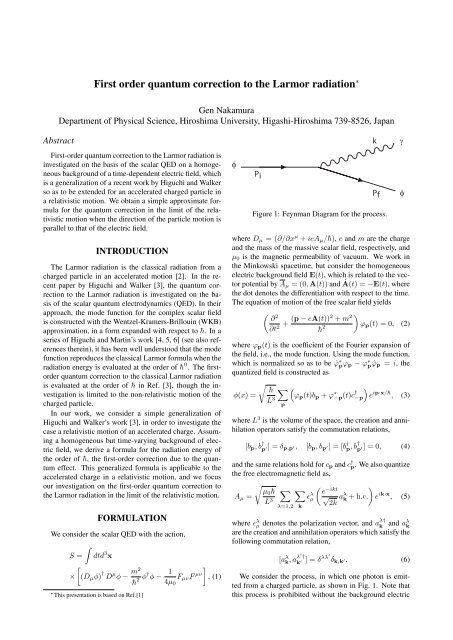Proceedings of International Conference on Physics in ... - KEK
Proceedings of International Conference on Physics in ... - KEK
Proceedings of International Conference on Physics in ... - KEK
Create successful ePaper yourself
Turn your PDF publications into a flip-book with our unique Google optimized e-Paper software.
First order quantum correcti<strong>on</strong> to the Larmor radiati<strong>on</strong> ∗<br />
Gen Nakamura<br />
Department <str<strong>on</strong>g>of</str<strong>on</strong>g> Physical Science, Hiroshima University, Higashi-Hiroshima 739-8526, Japan<br />
Abstract<br />
First-order quantum correcti<strong>on</strong> to the Larmor radiati<strong>on</strong> is<br />
<strong>in</strong>vestigated <strong>on</strong> the basis <str<strong>on</strong>g>of</str<strong>on</strong>g> the scalar QED <strong>on</strong> a homogeneous<br />
background <str<strong>on</strong>g>of</str<strong>on</strong>g> a time-dependent electric field, which<br />
is a generalizati<strong>on</strong> <str<strong>on</strong>g>of</str<strong>on</strong>g> a recent work by Higuchi and Walker<br />
so as to be extended for an accelerated charged particle <strong>in</strong><br />
a relativistic moti<strong>on</strong>. We obta<strong>in</strong> a simple approximate formula<br />
for the quantum correcti<strong>on</strong> <strong>in</strong> the limit <str<strong>on</strong>g>of</str<strong>on</strong>g> the relativistic<br />
moti<strong>on</strong> when the directi<strong>on</strong> <str<strong>on</strong>g>of</str<strong>on</strong>g> the particle moti<strong>on</strong> is<br />
parallel to that <str<strong>on</strong>g>of</str<strong>on</strong>g> the electric field.<br />
INTRODUCTION<br />
The Larmor radiati<strong>on</strong> is the classical radiati<strong>on</strong> from a<br />
charged particle <strong>in</strong> an accelerated moti<strong>on</strong> [2]. In the recent<br />
paper by Higuchi and Walker [3], the quantum correcti<strong>on</strong><br />
to the Larmor radiati<strong>on</strong> is <strong>in</strong>vestigated <strong>on</strong> the basis<br />
<str<strong>on</strong>g>of</str<strong>on</strong>g> the scalar quantum electrodynamics (QED). In their<br />
approach, the mode functi<strong>on</strong> for the complex scalar field<br />
is c<strong>on</strong>structed with the Wentzel-Kramers-Brillou<strong>in</strong> (WKB)<br />
approximati<strong>on</strong>, <strong>in</strong> a form expanded with respect to ¯h. In a<br />
series <str<strong>on</strong>g>of</str<strong>on</strong>g> Higuchi and Mart<strong>in</strong>’s work [4, 5, 6] (see also references<br />
there<strong>in</strong>), it has been well understood that the mode<br />
functi<strong>on</strong> reproduces the classical Larmor formula when the<br />
radiati<strong>on</strong> energy is evaluated at the order <str<strong>on</strong>g>of</str<strong>on</strong>g> ¯h 0 . The firstorder<br />
quantum correcti<strong>on</strong> to the classical Larmor radiati<strong>on</strong><br />
is evaluated at the order <str<strong>on</strong>g>of</str<strong>on</strong>g> ¯h <strong>in</strong> Ref. [3], though the <strong>in</strong>vestigati<strong>on</strong><br />
is limited to the n<strong>on</strong>-relativistic moti<strong>on</strong> <str<strong>on</strong>g>of</str<strong>on</strong>g> the<br />
charged particle.<br />
In our work, we c<strong>on</strong>sider a simple generalizati<strong>on</strong> <str<strong>on</strong>g>of</str<strong>on</strong>g><br />
Higuchi and Walker’s work [3], <strong>in</strong> order to <strong>in</strong>vestigate the<br />
case a relativistic moti<strong>on</strong> <str<strong>on</strong>g>of</str<strong>on</strong>g> an accelerated charge. Assum<strong>in</strong>g<br />
a homogeneous but time-vary<strong>in</strong>g background <str<strong>on</strong>g>of</str<strong>on</strong>g> electric<br />
field, we derive a formula for the radiati<strong>on</strong> energy <str<strong>on</strong>g>of</str<strong>on</strong>g><br />
the order <str<strong>on</strong>g>of</str<strong>on</strong>g> ¯h, the first-order correcti<strong>on</strong> due to the quantum<br />
effect. This generalized formula is applicable to the<br />
accelerated charge <strong>in</strong> a relativistic moti<strong>on</strong>, and we focus<br />
our <strong>in</strong>vestigati<strong>on</strong> <strong>on</strong> the first-order quantum correcti<strong>on</strong> to<br />
the Larmor radiati<strong>on</strong> <strong>in</strong> the limit <str<strong>on</strong>g>of</str<strong>on</strong>g> the relativistic moti<strong>on</strong>.<br />
FORMULATION<br />
We c<strong>on</strong>sider the scalar QED with the acti<strong>on</strong>,<br />
∫<br />
S = dtd 3 x<br />
×<br />
[<br />
(Dµφ) † D µ φ − m2<br />
¯h 2 φ† φ − 1<br />
∗ This presentati<strong>on</strong> is based <strong>on</strong> Ref.[1]<br />
4µ0<br />
FµνF µν<br />
]<br />
, (1)<br />
φ<br />
Pi<br />
k<br />
Pf<br />
Figure 1: Feynman Diagram for the process.<br />
where Dµ = (∂/∂x µ + ieAµ/¯h), e and m are the charge<br />
and the mass <str<strong>on</strong>g>of</str<strong>on</strong>g> the massive scalar field, respectively, and<br />
µ0 is the magnetic permeability <str<strong>on</strong>g>of</str<strong>on</strong>g> vacuum. We work <strong>in</strong><br />
the M<strong>in</strong>kowski spacetime, but c<strong>on</strong>sider the homogeneous<br />
electric background field E(t), which is related to the vector<br />
potential by Aµ = (0, A(t)) and ˙ A(t) = −E(t), where<br />
the dot denotes the differentiati<strong>on</strong> with respect to the time.<br />
The equati<strong>on</strong> <str<strong>on</strong>g>of</str<strong>on</strong>g> moti<strong>on</strong> <str<strong>on</strong>g>of</str<strong>on</strong>g> the free scalar field yields<br />
( ∂ 2<br />
∂t 2 + (p − eA(t))2 + m 2<br />
¯h 2<br />
γ<br />
φ<br />
)<br />
ϕp(t) = 0, (2)<br />
where ϕp(t) is the coefficient <str<strong>on</strong>g>of</str<strong>on</strong>g> the Fourier expansi<strong>on</strong> <str<strong>on</strong>g>of</str<strong>on</strong>g><br />
the field, i.e., the mode functi<strong>on</strong>. Us<strong>in</strong>g the mode functi<strong>on</strong>,<br />
which is normalized so as to be ˙ϕ ∗ pϕp − ϕ ∗ p ˙ϕp = i, the<br />
quantized field is c<strong>on</strong>structed as<br />
φ(x) =<br />
√ ¯h<br />
L 3<br />
∑<br />
p<br />
(<br />
ϕp(t)bp + ϕ ∗ −p(t)c †<br />
)<br />
−p e ip·x/¯h , (3)<br />
where L 3 is the volume <str<strong>on</strong>g>of</str<strong>on</strong>g> the space, the creati<strong>on</strong> and annihilati<strong>on</strong><br />
operators satisfy the commutati<strong>on</strong> relati<strong>on</strong>s,<br />
[bp, b †<br />
p ′] = δp,p ′, [bp, bp ′] = [b† p, b †<br />
′] = 0, (4)<br />
and the same relati<strong>on</strong>s hold for cp and c † p. We also quantize<br />
the free electromagnetic field as,<br />
Aµ =<br />
√ µ0¯h<br />
L 3<br />
∑<br />
λ=1,2<br />
∑<br />
k<br />
ɛ λ µ<br />
p<br />
( −ikt e<br />
√ a<br />
2k λ )<br />
k + h.c. e ik·x , (5)<br />
where ɛ λ µ denotes the polarizati<strong>on</strong> vector, and a λ†<br />
k and aλ k<br />
are the creati<strong>on</strong> and annihilati<strong>on</strong> operators which satisfy the<br />
follow<strong>in</strong>g commutati<strong>on</strong> relati<strong>on</strong>,<br />
[a λ k, a λ′ †<br />
k ′ ] = δ λλ′<br />
δk,k ′. (6)<br />
We c<strong>on</strong>sider the process, <strong>in</strong> which <strong>on</strong>e phot<strong>on</strong> is emitted<br />
from a charged particle, as shown <strong>in</strong> Fig. 1. Note that<br />
this process is prohibited without the background electric













